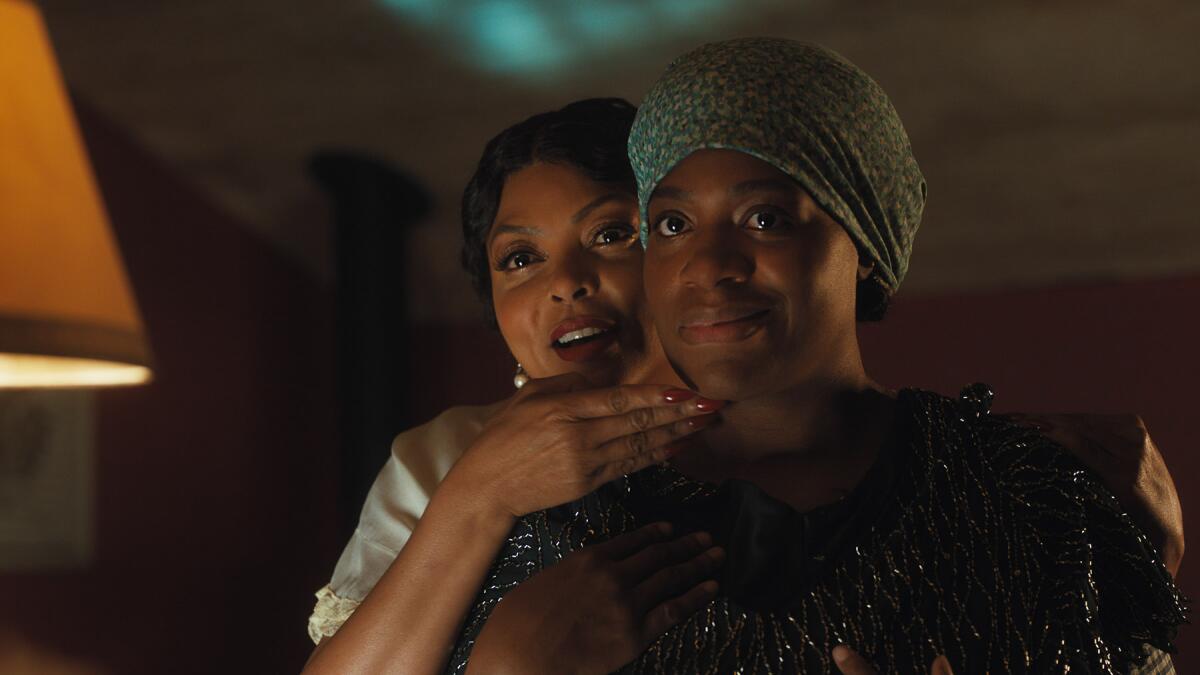Commentary: For all of its joy, ‘The Color Purple’ is also a chance to talk about Black women and intimate partner violence

The experiences of Black women who survive domestic violence can be framed in terms of hope but also the reality that their experiences are overlooked.
- Share via
While seeing “The Color Purple” earlier this month, I noticed the audience members gasped at the thwack sound when young Celie is first struck across the face after getting married and coming into Albert “Mister” Johnson’s home.
It was a momentary gasp, but still was one of the early moments that showed what Celie would endure for decades to come. But years after Alice Walker’s book was published in 1982, the first film came out in 1985, and the theater productions, hearing those gasps — even though many of us knew what was coming — showed how unbelievable it can still feel to see those flashes of violence right before us.
But there are certain politics that come with films that explore Black communities and stories of violence and trauma. There’s the usual question of why can’t more films and shows explore Black joy. There’s also the debates over the graphic nature of scenes showing violence, sexual assault, the realities of historical enslavement, and other anguishes Black people experience. And then there’s the sobering reality that there are so many stories we still do not know and perhaps will never know about Black history.
When the first “Color Purple” film came out in 1985 starring Whoopi Goldberg, Oprah Winfrey, Margaret Avery and Danny Glover, it was met with heavy criticism by prominent Black advocacy organizations, including the local NAACP Hollywood and Beverly Hills chapter. The film faced criticism for how Black men were portrayed and that it would be potentially devastating for Black people.
We saw versions of these debates with the 2009 film “Precious,” the 2010 film “For Colored Girls” and the 2013 film “12 Years a Slave.” All of the films in their own right inspired discussions about these depictions and what it means when art imitates life too close to home and our respective relationships with how we understand our willingness to engage with the intersection of trauma and pop culture. Anytime movies or shows like this are released it also means holding space for individuals who decline to watch — no matter how important they might become in Black pop culture history — for the sake of one’s peace and mental health, especially if there’s discomfort with talking about the topics.
A recent Times story talked about how the new “Color Purple” is designed to not necessarily overwhelm viewers about the traumas of Celie, played first by Phylicia Pearl Mpasi and then by Fantasia Barrino. The film segues into joyful bursts of song, choreography and moments of levity, as the Broadway musical did. But in between this, the film has to also be in line with the book, where Celie suffers physical and emotional abuse over decades.

I was touched by the songs and performances, but the new “The Color Purple” film — for all of its joy — should still be allowed to be an important cultural reflection on how we talk about various kinds of violence against Black women. While it has endured for decades on the page, on the screen and on the stage for its depth, the way intimate partner violence is talked about, studied and analyzed has slowly changed too. Eleven years after the book was published, the public health community started to consider domestic violence a public health issue. The data from a federal report from 1995-1996 were the first to document the incidence and prevalence of intimate partner violence, sexual violence and stalking. The most recent data available from the National Intimate Partner and Sexual Violence Survey from 2016-2017 found that nearly 54% of Black women said that they had experienced sexual violence, physical violence, and/or stalking by an intimate partner during their lifetimes.
That’s a sobering statistic and rarely acknowledged reality that illustrate why it’s difficult to have fruitful conversations about the dynamics that Black women face with domestic violence. The book, theater and film depictions of “The Color Purple” at their cores present an important story about the resilience of Black women. Resilience is a muscle that takes time to develop individually and communally. But resilience also requires reckoning with reality. The reality here is that we still struggle to speak about intimate partner violence, including what it looks like, who it can happen to and assuming that extracting oneself from an abusive relationship is a simple task. In order to appreciate Celie’s path to freedom, you have to bear witness and sit with the uncomfortable and complex truths about the harm she endured whether reading it or watching it. The other reality is resilience is not always enough for Black women to overcome the challenges of social, systemic and institutional misogynoir.
The experiences of Black women who survive domestic violence cannot only be framed in terms of hope but also the weight of the reality that their experiences are overlooked. What’s more, to appreciate the 1985 film and the 2023 one, is to also appreciate the work the Black actors and actresses did to bring Walker’s work to life. It’s not only about talented performances but also the willingness and courage of each cast member to immerse themselves in the darker parts of the material that reflect on the human heaviness of abuse and violence. We see that especially for Barrino, who has played Celie before and is also a survivor of sexual assault.
When Glover and Colman Domingo deliver the “you’re Black, you’re poor, you’re ugly, you’re a woman “ line in the films, it underscored all of the emotional and mental abuse that Celie dealt with as well as the tangible manipulations that often keep Black women from leaving abusive relationships. That includes not having the financial means to leave and being told no one in the world would want them. The cruelty of that line, even after first appearing in the book 41 years ago, has a haunting resonance because these tactics — isolation, financial dependence, physical violence — are still used by abusers today to prevent women from leaving.
For all of the music and joy in the new film, we shouldn’t allow it to lose sight of the fact that whether we know it or not, we all know or are in proximity to a Black woman like Celie even in the year 2023. For every Celie who does “overcome those obstacles to freedom” with domestic violence, there’s a Black woman who dies trying to do the same. We cannot properly reflect on the courage of Celie’s story in the film remake without also having the courage to talk about how modern day domestic violence happens and our role as a collective to prevent it or stop it before it’s too late.
More to Read
The biggest entertainment stories
Get our big stories about Hollywood, film, television, music, arts, culture and more right in your inbox as soon as they publish.
You may occasionally receive promotional content from the Los Angeles Times.
![Taraji P. Henson and Fantasia Barrino in "The Color Purple." [[CROPPED VERSION OF PHOTO]]](https://ca-times.brightspotcdn.com/dims4/default/751b22e/2147483647/strip/true/crop/1674x1116+200+0/resize/840x560!/quality/75/?url=https%3A%2F%2Fcalifornia-times-brightspot.s3.amazonaws.com%2F7b%2F73%2F73362a9c4c5699720bfe03bbb1f9%2Ftcp-t2-0089-crop.jpg)











